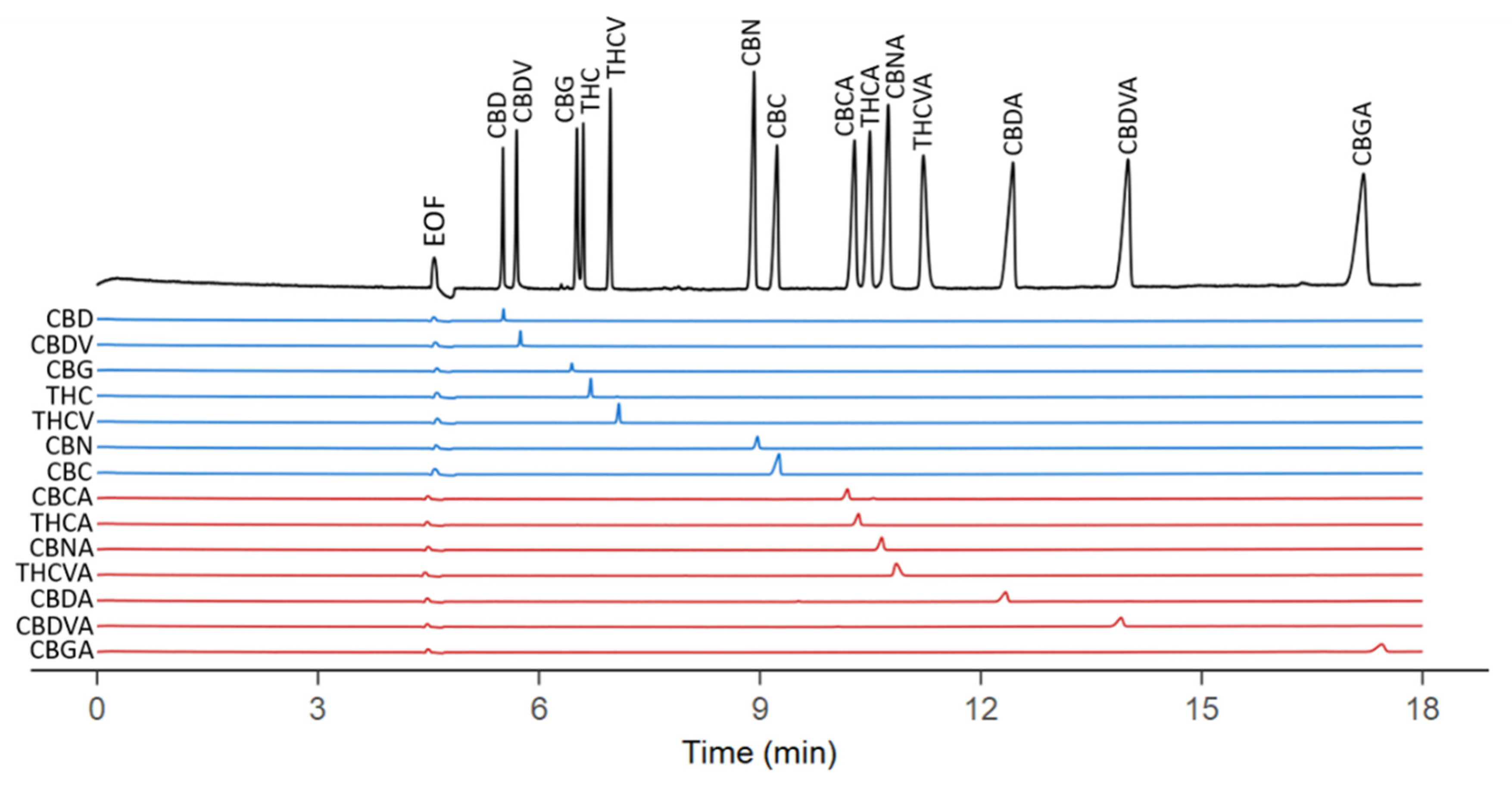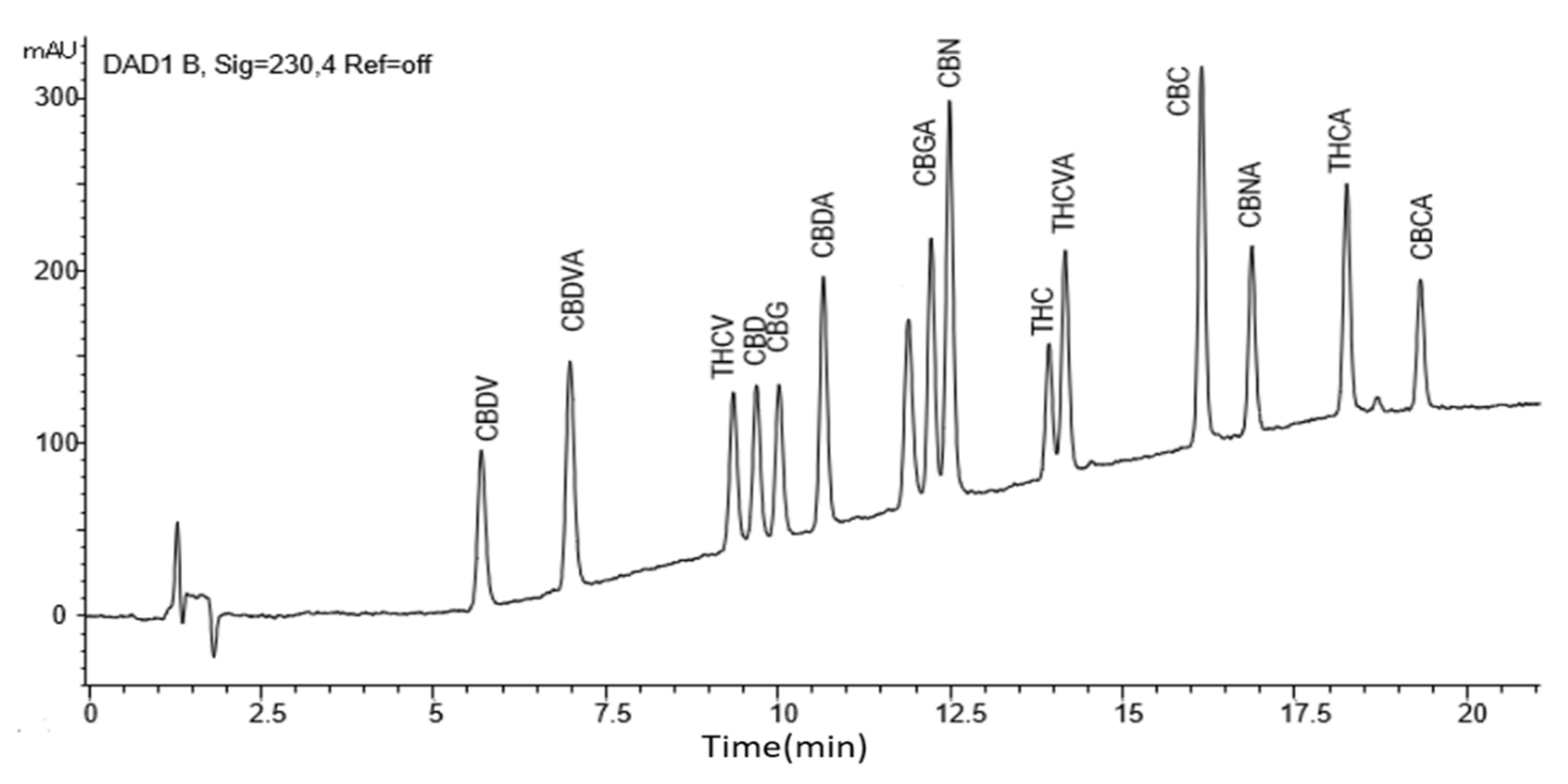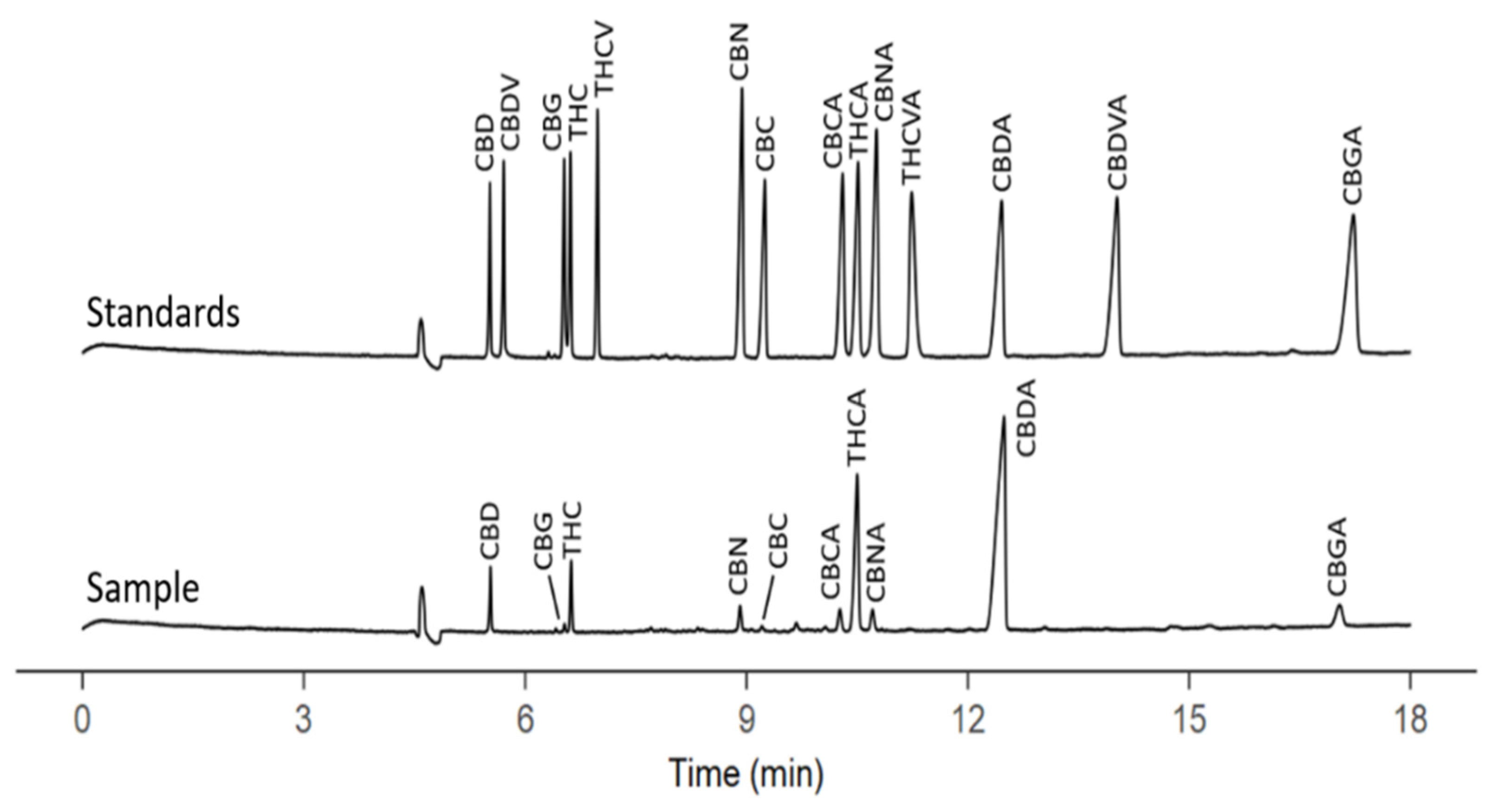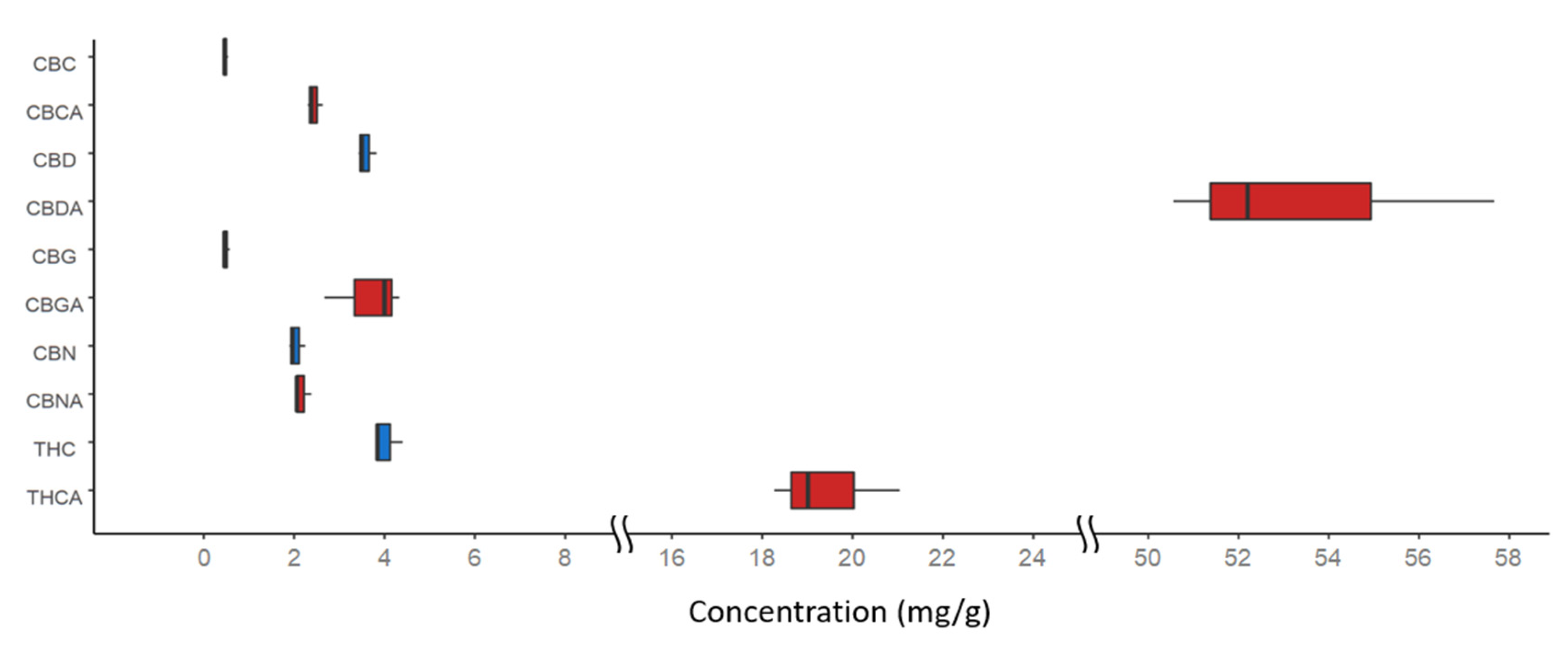Single-Run Separation and Quantification of 14 Cannabinoids Using Capillary Electrophoresis
Abstract
1. Introduction
2. Materials and Methods
2.1. Plant Extraction
2.2. Capillary Electrophoresis
2.3. HPLC
2.4. Reproducibility
2.5. Limit of Detection and Quantification
3. Results and Discussion
3.1. Method
3.2. Quantitation of Cannabinoids in Samples
4. Conclusions
Supplementary Materials
Author Contributions
Funding
Institutional Review Board Statement
Informed Consent Statement
Data Availability Statement
Conflicts of Interest
References
- Small, E.; Cronquist, A. A practical and natural taxonomy for Cannabis. Taxon 1976, 25, 405–435. [Google Scholar] [CrossRef]
- McPartland, J.M. Cannabis systematics at the levels of family, genus, and species. Cannabis Cannabinoid Res. 2018, 3, 203–212. [Google Scholar] [CrossRef] [PubMed]
- Crippa, J.A.; Zuardi, A.W.; Martín-Santos, R.; Bhattacharyya, S.; Atakan, Z.; McGuire, P.; Fusar-Poli, P. Cannabis and anxiety: A critical review of the evidence. Hum. Psychopharmacol. Clin. Exp. 2009, 24, 515–523. [Google Scholar] [CrossRef]
- Mattes, R.D.; Engelman, K.; Shaw, L.M.; Elsohly, M.A. Cannabinoids and appetite stimulation. Pharmacol. Biochem. Behav. 1994, 49, 187–195. [Google Scholar] [CrossRef]
- Karst, M.; Wippermann, S.; Ahrens, J. Role of cannabinoids in the treatment of pain and (painful) spasticity. Drugs 2010, 70, 2409–2438. [Google Scholar] [CrossRef] [PubMed]
- Babson, K.A.; Bonn-Miller, M.O. Sleep disturbances: Implications for cannabis use, cannabis use cessation, and cannabis use treatment. Curr. Addict. Rep. 2014, 1, 109–114. [Google Scholar] [CrossRef]
- Gazette, C. Order Fixing 17 October 2018 as the Day on which Certain Provisions of the Act Come into Force. Available online: http://www.gazette.gc.ca/rp-pr/p2/2018/2018-07-11/html/si-tr52-eng.html (accessed on 17 October 2018).
- The Cannabis Act: The Facts. Available online: https://www.canada.ca/en/health-canada/news/2018/06/backgrounder-the-cannabis-act-the-facts.html (accessed on 20 June 2018).
- State Medical Marijuana Laws. Available online: https://www.ncsl.org/research/health/state-medical-marijuana-laws.aspx (accessed on 1 March 2021).
- Dei Cas, M.; Casagni, E.; Saccardo, A.; Arnoldi, S.; Young, C.; Scotti, S.; de Manicor, E.V.; Gambaro, V.; Roda, G. The Italian panorama of cannabis light preparation: Determination of cannabinoids by LC-UV. Forensic Sci. Int. 2020, 307, 110113. [Google Scholar] [CrossRef] [PubMed]
- ElSohly, M.A.; Radwan, M.M.; Gul, W.; Chandra, S.; Galal, A. Phytochemistry of Cannabis sativa L. Phytocannabinoids 2017, 103, 1–36. [Google Scholar]
- Dussy, F.E.; Hamberg, C.; Luginbühl, M.; Schwerzmann, T.; Briellmann, T.A. Isolation of Δ9-THCA-A from hemp and analytical aspects concerning the determination of Δ9-THC in cannabis products. Forensic Sci. Int. 2005, 149, 3–10. [Google Scholar] [CrossRef]
- Yamauchi, T.; Shoyama, Y.; Aramaki, H.; Azuma, T.; Nishioka, I. Tetrahydrocannabinolic acid, a genuine substance of tetrahydrocannabinol. Chem. Pharm. Bull. 1967, 15, 1075–1076. [Google Scholar] [CrossRef] [PubMed]
- Mandrioli, M.; Tura, M.; Scotti, S.; Gallina Toschi, T. Fast Detection of 10 Cannabinoids by RP-HPLC-UV Method in Cannabis sativa L. Molecules 2019, 24, 2113. [Google Scholar] [CrossRef] [PubMed]
- Backofen, U.; Matysik, F.-M.; Lunte, C.E. Determination of cannabinoids in hair using high-pH non-aqueous electrolytes and electrochemical detection: Some aspects of sensitivity and selectivity. J. Chromatogr. A 2002, 942, 259–269. [Google Scholar] [CrossRef]
- Mazina, J.; Spiljova, A.; Vaher, M.; Kaljurand, M.; Kulp, M. A rapid capillary electrophoresis method with LED-induced native fluorescence detection for the analysis of cannabinoids in oral fluid. Anal. Methods 2015, 7, 7741–7747. [Google Scholar] [CrossRef]
- Lurie, I.S.; Meyers, R.P.; Conver, T.S. Capillary electrochromatography of cannabinoids. Anal. Chem. 1998, 70, 3255–3260. [Google Scholar] [CrossRef] [PubMed]
- Gottardo, R.; Bertaso, A.; Pascali, J.; Sorio, D.; Musile, G.; Trapani, E.; Seri, C.; Serpelloni, G.; Tagliaro, F. Micellar electrokinetic chromatography: A new simple tool for the analysis of synthetic cannabinoids in herbal blends and for the rapid estimation of their log P values. J. Chromatogr. A 2012, 1267, 198–205. [Google Scholar] [CrossRef] [PubMed]
- Cheng, H.-L.; Tsai, Y.-H.; Hsu, W.-L.; Lin, Y.-H. An on-line stacking capillary electrophoresis method for the analysis of Δ9-tetrahydrocannabinol and its metabolites. J. Chromatogr. A 2015, 1426, 226–232. [Google Scholar] [CrossRef] [PubMed]
- Hippalgaonkar, K.; Gul, W.; ElSohly, M.A.; Repka, M.A.; Majumdar, S. Enhanced solubility, stability, and transcorneal permeability of delta-8-tetrahydrocannabinol in the presence of cyclodextrins. Aaps Pharmscitech 2011, 12, 723–731. [Google Scholar] [CrossRef] [PubMed]
- Schmitt-Kopplin, P.; Garmash, A.V.; Kudryavtsev, A.V.; Menzinger, F.; Perminova, I.V.; Hertkorn, N.; Freitag, D.; Petrosyan, V.S.; Kettrup, A. Quantitative and qualitative precision improvements by effective mobility-scale data transformation in capillary electrophoresis analysis. Electrophoresis 2001, 22, 77–87. [Google Scholar] [CrossRef]
- da Silva Júnior, W.F.; de Oliveira Pinheiro, J.G.; Moreira, C.D.; de Souza, F.J.; de Lima, Á.A. Alternative technologies to improve solubility and stability of poorly water-soluble drugs. Multifunct. Syst. Comb. Deliv. Biosensing Diagn. 2017, 281–305. [Google Scholar] [CrossRef]





| Compound Name | LOD (µg/mL) | LOQ (µg/mL) |
|---|---|---|
| CBD | 1.3 | 3.8 |
| CBDV | 1.2 | 3.7 |
| CBG | 1.5 | 4.6 |
| THC | 1.2 | 3.7 |
| THCV | 1.3 | 4.0 |
| CBN | 1.4 | 4.1 |
| CBC | 1.2 | 3.7 |
| CBCA | 1.4 | 4.3 |
| THCA | 1.3 | 3.8 |
| CBNA | 1.4 | 4.3 |
| THCVA | 1.6 | 4.8 |
| CBDA | 1.4 | 4.1 |
| CBDVA | 1.8 | 5.4 |
| CBGA | 1.7 | 5.0 |
Publisher’s Note: MDPI stays neutral with regard to jurisdictional claims in published maps and institutional affiliations. |
© 2021 by the authors. Licensee MDPI, Basel, Switzerland. This article is an open access article distributed under the terms and conditions of the Creative Commons Attribution (CC BY) license (http://creativecommons.org/licenses/by/4.0/).
Share and Cite
Zaripov, E.A.; Lee, T.; Dou, Y.; Harris, C.S.; Egorov, A.; Berezovski, M.V. Single-Run Separation and Quantification of 14 Cannabinoids Using Capillary Electrophoresis. Separations 2021, 8, 30. https://doi.org/10.3390/separations8030030
Zaripov EA, Lee T, Dou Y, Harris CS, Egorov A, Berezovski MV. Single-Run Separation and Quantification of 14 Cannabinoids Using Capillary Electrophoresis. Separations. 2021; 8(3):30. https://doi.org/10.3390/separations8030030
Chicago/Turabian StyleZaripov, Emil A., Tiah Lee, Yuchu Dou, Cory S. Harris, Artem Egorov, and Maxim V. Berezovski. 2021. "Single-Run Separation and Quantification of 14 Cannabinoids Using Capillary Electrophoresis" Separations 8, no. 3: 30. https://doi.org/10.3390/separations8030030
APA StyleZaripov, E. A., Lee, T., Dou, Y., Harris, C. S., Egorov, A., & Berezovski, M. V. (2021). Single-Run Separation and Quantification of 14 Cannabinoids Using Capillary Electrophoresis. Separations, 8(3), 30. https://doi.org/10.3390/separations8030030








